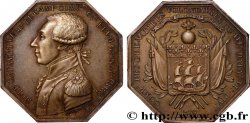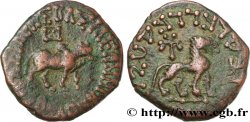fjt_01156 - LAFAYETTE (MARIE-JOSEPH-PAUL-ROCH-YVES-GILBERT MOTIER, MARQUIS OF) GARDE NATIONALE DE PARIS 1789
Not available.
Item sold on our e-shop (2014)
Price : 75.00 €
Item sold on our e-shop (2014)
Price : 75.00 €
Type : GARDE NATIONALE DE PARIS
Date: 1789
Metal : brass
Diameter : 32 mm
Orientation dies : 12 h.
Edge : lisse
Rarity : R1
Catalogue references :
Obverse
Obverse legend : MIS. DE. LAFAYETTE. MAL. DE. CAMP. COMDANT. GAL. DE. LA. GDE. NALE. PARNE.
Obverse description : Buste de La Fayette à gauche signé Dumarest F.
Reverse
Reverse legend : COMPIE. DES. GRENADIERS. VOLONTAIRES. DU. IIIE. BATAON. VIE. DIVON.
Reverse description : Armes de Paris sur des drapeaux, surmontées d'une grenade ; au-dessus, une banderole portant l'inscription VIVRE. LIBRE. OU. MOURIR.
Commentary
Refrappe certaine bien que le jeton soit sans poinçon. Ce type de refrappe a été fait pour collectionneurs et pour pallier à l’impossibilité de trouver certains jetons, rarissimes voire inconnus en frappe originale. En vingt ans de commerce de jetons nous n’avons jamais pu offrir ce jeton en original.
Certain re-strike although the token is without a hallmark. This type of re-strike was done for collectors and to compensate for the impossibility of finding certain tokens, extremely rare or even unknown in original strike. In twenty years of trading tokens we have never been able to offer this token in original strike
Certain re-strike although the token is without a hallmark. This type of re-strike was done for collectors and to compensate for the impossibility of finding certain tokens, extremely rare or even unknown in original strike. In twenty years of trading tokens we have never been able to offer this token in original strike








 Report a mistake
Report a mistake Print the page
Print the page Share my selection
Share my selection Ask a question
Ask a question Consign / sell
Consign / sell
 Full data
Full data





